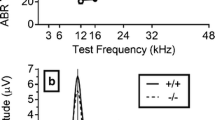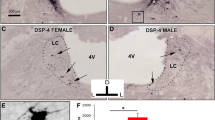Abstract
The acoustic startle reflex in rats can be inhibited if a prepulse stimulus is presented just before the startle stimulus (prepulse inhibition; PPI). When postnatal day 7 (P7) rats are exposed to agents that block the NMDA receptor (NMDAR), robust apoptosis is observed within hours and is thought to be followed at later ages by a significant loss of PPI. To understand these observations further, we exposed rat pups to vehicle or the NMDAR antagonist MK801 (1 mg/kg) at P6, P8, and P10. We then examined animals for PPI at P28 and P56. Compared to vehicle controls, we found no evidence for PPI deficits in the MK801-treated group, although we did observe prepulse-induced delay in response time at P56 (but not at P28). In a parallel study, we also performed histological analysis of brain sections for evidence of the pro-apoptotic marker activated caspase-3, 8 h after vehicle or MK801 injection into P6 animals. We found that there was a robust increase in this marker of cell death in the inferior colliculus of MK801 compared to vehicle-treated animals. Thus, transient blockade of the NMDAR during the postnatal period not only promotes early apoptosis in a brain region critical for acoustic processing but also leads to auditory deficits at a later age, suggesting that injury-induced loss of collicular neurons leads to network reorganization in the auditory system that is progressive in nature.



Similar content being viewed by others
References
Blumenthal TD (1999) Short lead interval modification. In: Dawson ME, Schell AM, Boehmelt AH (eds) Startle modification: implications for neuroscience cognitive science and clinical science. Cambridge University Press, Cambridge, pp 51–77
Blumenthal TD, Berg WK (1986) Stimulus rise time, intensity, and bandwidth effects on acoustic startle amplitude and probability. Psychophysiology 23:635–641
Blumenthal TD, Elden A, Flaten MA (2004) A comparison of several methods used to quantify prepulse inhibition of eyeblink responding. Psychophysiology 41:326–332
Boctor SY, Ferguson SA (2009) Neonatal NMDA receptor antagonist treatments have no effects on prepulse inhibition of postnatal day 25 Sprague–Dawley rats. Neurotoxicology 30:151–154
Boctor SY, Wang C, Ferguson SA (2008) Neonatal PCP is more potent than ketamine at modifying preweaning behaviors of Sprague–Dawley rats. Toxicol Sci 106:172–179
Davis M, Gendelman DS, Tischler MD, Gendelman PM (1982) A primary acoustic startle circuit: lesion and stimulation studies. J Neurosci 2:791–805
Eastwood SL (2004) The synaptic pathology of schizophrenia: is aberrant neurodevelopment and plasticity to blame? Int Rev Neurobiol 59:47–72
Fredriksson A, Archer T, Alm H, Gordh T, Eriksson P (2004) Neurofunctional deficits and potentiated apoptosis by neonatal NMDA antagonist administration. Behav Brain Res 153:367–376
Friauf E, Lohmann C (1999) Development of auditory brainstem circuitry activity-dependent and activity-independent processes. Cell Tissue Res 297:187–195
Geyer MA, Swerdlow NR, Mansbach RS, Braff DL (1990) Startle response models of sensorimotor gating and habituation deficits in schizophrenia. Brain Res Bull 25:485–498
Harris LW, Sharp T, Gartlon J, Jones DN, Harrison PJ (2003) Long-term behavioural, molecular and morphological effects of neonatal NMDA receptor antagonism. Eur J Neurosci 18:1706–1710
Ikonomidou C, Bosch F, Miksa M, Bittigau P, Vockler J, Dikranian K, Tenkova TI, Stefovska V, Turski L, Olney JW (1999) Blockade of NMDA receptors and apoptotic neurodegeneration in the developing brain. Science 283:70–74
Jevtovic-Todorovic V, Hartman RE, Izumi Y, Benshoff ND, Dikranian K, Zorumski CF, Olney JW, Wozniak DF (2003) Early exposure to common anesthetic agents causes widespread neurodegeneration in the developing rat brain and persistent learning deficits. J Neurosci 23:876–882
Johnson KM, Phillips M, Wang C, Kevetter GA (1998) Chronic phencyclidine induces behavioral sensitization and apoptotic cell death in the olfactory and piriform cortex. J Neurosci Res 52:709–722
Kaindl AM, Koppelstaetter A, Nebrich G, Stuwe J, Sifringer M, Zabel C, Klose J, Ikonomidou C (2008) Brief alteration of NMDA or GABAA receptor-mediated neurotransmission has long term effects on the developing cerebral cortex. Mol Cell Proteomics 7:2293–2310
Leitner DS, Cohen ME (1985) Role of the inferior colliculus in the inhibition of acoustic startle in the rat. Physiol Behav 34:65–70
Lema Tomé CM, Bauer C, Nottingham C, Smith C, Blackstone K, Brown L, Hlavaty C, Nelson C, Daker R, Sola R, Miller R, Bryan R, Turner CP (2006a) MK801-induced caspase-3 in the postnatal brain: inverse relationship with calcium binding proteins. Neuroscience 141:1351–1363
Lema Tomé CM, Nottingham CU, Smith CM, Beauchamp AS, Leung PW, Turner CP (2006b) Neonatal exposure to MK801 induces structural reorganization of the central nervous system. Neuroreport 17:779–783
Li L, Korngut LM, Frost BJ, Beninger RJ (1998) Prepulse inhibition following lesions of the inferior colliculus: prepulse intensity functions. Physiol Behav 65:133–139
Lu LX, Yon JH, Carter LB, Jevtovic-Todorovic V (2006) General anesthesia activates BDNF-dependent neuroapoptosis in the developing rat brain. Apoptosis 11:1603–1615
Martinez ZA, Halim ND, Oostwegel JL, Geyer MA, Swerdlow NR (2000) Ontogeny of phencyclidine and apomorphine-induced startle gating deficits in rats. Pharmacol Biochem Behav 65:449–457
Paxinos G, Watson A (1998) The rat brain in stereotaxic coordinates. Academic Press, San Diego
Rasmussen BA, O’Neil J, Manaye KF, Perry DC, Tizabi Y (2007) Long-term effects of developmental PCP administration on sensorimotor gating in male and female rats. Psychopharmacology (Berl) 190:43–49
Remschmidt H (2002) Early-onset schizophrenia as a progressive-deteriorating developmental disorder: evidence from child psychiatry. J Neural Transm 109:101–117
Rice D, Barone S Jr (2000) Critical periods of vulnerability for the developing nervous system: evidence from humans and animal models. Environ Health Perspect 108(Suppl 3):511–533
Ringler SL, Aye J, Byrne E, Anderson M, Turner CP (2008) Effects of disrupting calcium homeostasis on neuronal maturation: early inhibition and later recovery. Cell Mol Neurobiol 28:389–409
Silva RC, Sandner G, Brandao ML (2005) Unilateral electrical stimulation of the inferior colliculus of rats modifies the prepulse modulation of the startle response (PPI): effects of ketamine and diazepam. Behav Brain Res 160:323–330
Swerdlow NR, Braff DL, Taaid N, Geyer MA (1994) Assessing the validity of an animal model of deficient sensorimotor gating in schizophrenic patients. Arch Gen Psychiatry 51:139–154
Swerdlow NR, Geyer MA, Braff DL (2001) Neural circuit regulation of prepulse inhibition of startle in the rat: current knowledge and future challenges. Psychopharmacology (Berl) 156:194–215
Turner CP, Pulciani D, Rivkees SA (2002) Reduction in intracellular calcium levels induces injury in developing neurons. Exp Neurol 178:21–32
Turner CP, Miller R, Smith C, Brown L, Blackstone K, Dunham SR, Strehlow R, Manfredi M, Slocum P, Iverson K, West M, Ringler SL, Berry ZC (2007) Widespread neonatal brain damage following calcium channel blockade. Dev Neurosci 29:213–231
Turner CP, Debenedetto D, Liu C (2009a) NMDAR blockade-induced neonatal brain injury: reversal by the calcium channel agonist BayK 8644. Neurosci Lett 450:292–295
Turner CP, Debenedetto D, Ware E, Stowe R, Lee A, Swanson J, Walburg C, Lambert A, Lyle M, Desai P, Liu C (2009b) Postnatal exposure to MK801 induces selective changes in GAD67 or parvalbumin. Unpublished observations
Wang CZ, Johnson KM (2007) The role of caspase-3 activation in phencyclidine-induced neuronal death in postnatal rats. Neuropsychopharmacology 32:1178–1194
Wang C, McInnis J, Ross-Sanchez M, Shinnick-Gallagher P, Wiley JL, Johnson KM (2001) Long-term behavioral and neurodegenerative effects of perinatal phencyclidine administration: implications for schizophrenia. Neuroscience 107:535–550
Wang C, McInnis J, West JB, Bao J, Anastasio N, Guidry JA, Ye Y, Salvemini D, Johnson KM (2003) Blockade of phencyclidine-induced cortical apoptosis and deficits in prepulse inhibition by M40403, a superoxide dismutase mimetic. J Pharmacol Exp Ther 304:266–271
Wang C, Anastasio N, Popov V, Leday A, Johnson KM (2004) Blockade of N-methyl-d-aspartate receptors by phencyclidine causes the loss of corticostriatal neurons. Neuroscience 125:473–483
Weinberger DR (1996) On the plausibility of “the neurodevelopmental hypothesis” of schizophrenia. Neuropsychopharmacology 14:1S–11S
Acknowledgments
The authors are indebted to Jody Roberts for her technical support and training efforts in establishing the PPI behavioral assay. These studies were supported by NIH RO1 051632 and a Wake Forest University Cross Campus Collaboration Research Support Fund grant to CPT and TDB. Immunohistochemistry performed by CL, image analysis and cell counts by CL and CPT, acoustic startle (PPI) assay performed by AL and JS, and data analysis by AL, JS, TDB, and CPT. Manuscript preparation by AL, TDB, and CPT.
Author information
Authors and Affiliations
Corresponding author
Additional information
A. Lyall and J. Swanson are co-first authors.
Rights and permissions
About this article
Cite this article
Lyall, A., Swanson, J., Liu, C. et al. Neonatal exposure to MK801 promotes prepulse-induced delay in startle response time in adult rats. Exp Brain Res 197, 215–222 (2009). https://doi.org/10.1007/s00221-009-1906-2
Received:
Accepted:
Published:
Issue Date:
DOI: https://doi.org/10.1007/s00221-009-1906-2




